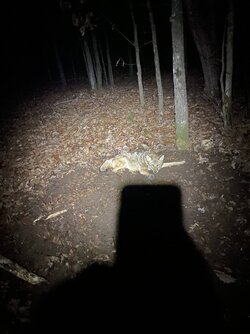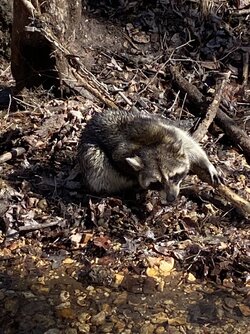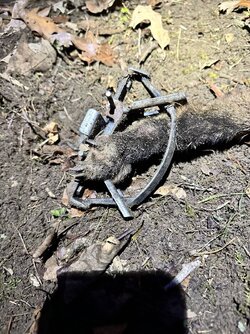Neighbors cat and 2 possums today. The cat was let loose unharmed. I let her out and she rubbed on me for a second like saying thank you then took off. And I say neighbors cat because I just assume it's their cat. They live about 500 yards away but don't talk to them much to know if it is or not.



You are using an out of date browser. It may not display this or other websites correctly.
You should upgrade or use an alternative browser.
You should upgrade or use an alternative browser.
Trapline pictures thread
- Thread starter jman 125
- Start date
deerkiller300wsm
Well-Known Member
Saving quail and turkey one kitty at a time….. you're a better man than me. If a cat ain't killing mice in the shed or barn, he's killing small game. Take all the possums you can! I do!!! They actually make a very pretty hide. Especially the big onesNeighbors cat and 2 possums today. The cat was let loose unharmed. I let her out and she rubbed on me for a second like saying thank you then took off. And I say neighbors cat because I just assume it's their cat. They live about 500 yards away but don't talk to them much to know if it is or not.
View attachment 214178
View attachment 214179
View attachment 214180
jman 125
Well-Known Member
Waiting to be petted.

jman 125
Well-Known Member
Big male.

square
Well-Known Member
- Joined
- Jun 4, 2020
- Messages
- 4,104
I would have put that cat down! Only good cat is a dead one. All they do is kill songbirds.Neighbors cat and 2 possums today. The cat was let loose unharmed. I let her out and she rubbed on me for a second like saying thank you then took off. And I say neighbors cat because I just assume it's their cat. They live about 500 yards away but don't talk to them much to know if it is or not.
View attachment 214178
View attachment 214179
View attachment 214180
I'm not putting some kids cat down because it kills a bird. To each their own.I would have put that cat down! Only good cat is a dead one. All they do is kill songbirds.
- Joined
- Jun 4, 2020
- Messages
- 4,104
People that love their pets don't let them roam and trespass.I'm not putting some kids cat down because it kills a bird. To each their own.
jman 125
Well-Known Member
People that love their pets don't let them roam and trespass.
And its comments like this is what puts trappers in a bad light .I would have put that cat down! Only good cat is a dead one. All they do is kill songbirds.
While i do agree they should keep it on their property.
jman 125
Well-Known Member
You did the right thingI'm not putting some kids cat down because it kills a bird. To each their own.
- Joined
- Jun 4, 2020
- Messages
- 4,104
Don't worry. I'm too lazy to trap anything. I just don't like cats.And its comments like this is what puts trappers in a bad light .
While i do agree they should keep it on their property.
kaizen leader
Well-Known Member
Indoor Cats vs. Outdoor Cats
Like many cat lovers, you may have thought about letting your cat go outside. A lot of cat owners feel guilty about keeping their cat inside, and worry that they are depriving their cat of natural instincts or fresh air and sunshine. If you have experienced some of these feelings, American Humane Association appreciates your concern for your feline friend and would like to help you make an educated decision. Let's look at the issues surrounding indoor vs. outdoor cats:
Health Concerns
Disease:
The American Feral Cat Coalition estimates that there are approximately 60 million feral and homeless stray cats living in the U.S. Many of these cats may carry diseases that can be passed on to your cat if he or she comes into contact with them. A number of these diseases can be serious or potentially fatal. Common examples include:
While usually not life-threatening for cats, several common parasites can be picked up by your kitty when venturing outdoors, including:
If You Decide to Let Your Cat Outside:
A major consideration for cat lovers thinking about letting their cat venture outdoors is safety. In addition to the risks posed by fellow cats, other potential hazards that can seriously threaten your cat's well-being -- and even her life – include:
Cars:
Contrary to popular belief, cats do not have the innate instinct to avoid busy streets, and they frequently get hit by cars.
Animal cruelty:
Roaming cats may be at risk for animal cruelty. Sadly, some people have been known to shoot cats with BB guns or arrows, while some cats end up being trapped, abused and killed in the name of "sport" or "for fun."
Loose dogs and wild animals:
We may think of our feisty felines as good hunters who are capable of taking care of themselves with sharp teeth and claws. Unfortunately, cats may be good hunters, but they also often wind up being hunted. Cats are commonly attacked by loose dogs and wild animals, such as coyotes, raccoons, foxes and even alligators (depending on where they live). Injuries from wild animal and stray dog attacks are very serious and often fatal.
Toxins and poisons: Outside cats also face danger from coming into contact with toxins, such as antifreeze, that are often ingested because they have a pleasant taste. Cats may also end up accidently exposed to rodent poisons when they hunt and eat rodents that have recently ingested poison bait.
Trees: Trees can be a source of some danger for cats who climb to a place where they are afraid or unable to climb down. In some cases, they may be up in a tree for days until they become so severely dehydrated and weak that they fall and suffer severe, serious or fatal injuries.
Environmental Concerns
Killing birds and small animals:
A cat's prey drive is so strong that even well-fed cats may naturally enjoy hunting birds or other small animals. Although the impact made by one cat might not seem like a big deal, it is important to think about the total impact of all the cats who are allowed outside. Loose cats are estimated to kill hundreds of millions of birds each year, yet birds are believed to be only 20 percent of the wildlife stray cats kill.1 Birds are especially at risk around homes with feeders and birdbaths.1
If you truly love your cat you will follow these professional guidelines.
References
1 Kress, Steve (2008). Audubon Living: Cats. Audubon Magazine, November-December.
Like many cat lovers, you may have thought about letting your cat go outside. A lot of cat owners feel guilty about keeping their cat inside, and worry that they are depriving their cat of natural instincts or fresh air and sunshine. If you have experienced some of these feelings, American Humane Association appreciates your concern for your feline friend and would like to help you make an educated decision. Let's look at the issues surrounding indoor vs. outdoor cats:
Health Concerns
Disease:
The American Feral Cat Coalition estimates that there are approximately 60 million feral and homeless stray cats living in the U.S. Many of these cats may carry diseases that can be passed on to your cat if he or she comes into contact with them. A number of these diseases can be serious or potentially fatal. Common examples include:
- feline leukemia (FeLV)
- feline AIDS (FIV)
- FIP (feline infectious peritonitis)
- feline distemper (panleukopenia)
- upper respiratory infections (or URI).
While usually not life-threatening for cats, several common parasites can be picked up by your kitty when venturing outdoors, including:
- fleas
- ticks
- ear mites
- intestinal worms
- ringworm (a fungal infection)
If You Decide to Let Your Cat Outside:
- Protect your kitty from other cats. Keep her on a leash or secured in a cage or other confined space where she can't get out (and other cats can't get in).
- Make sure an adult supervises your kitty's outdoor time to ensure strays cannot come into contact with her.
- Take her to the veterinarian at least once every year for lifesaving vaccines, as well as parasite screening and treatment.
A major consideration for cat lovers thinking about letting their cat venture outdoors is safety. In addition to the risks posed by fellow cats, other potential hazards that can seriously threaten your cat's well-being -- and even her life – include:
Cars:
Contrary to popular belief, cats do not have the innate instinct to avoid busy streets, and they frequently get hit by cars.
Animal cruelty:
Roaming cats may be at risk for animal cruelty. Sadly, some people have been known to shoot cats with BB guns or arrows, while some cats end up being trapped, abused and killed in the name of "sport" or "for fun."
Loose dogs and wild animals:
We may think of our feisty felines as good hunters who are capable of taking care of themselves with sharp teeth and claws. Unfortunately, cats may be good hunters, but they also often wind up being hunted. Cats are commonly attacked by loose dogs and wild animals, such as coyotes, raccoons, foxes and even alligators (depending on where they live). Injuries from wild animal and stray dog attacks are very serious and often fatal.
Toxins and poisons: Outside cats also face danger from coming into contact with toxins, such as antifreeze, that are often ingested because they have a pleasant taste. Cats may also end up accidently exposed to rodent poisons when they hunt and eat rodents that have recently ingested poison bait.
Trees: Trees can be a source of some danger for cats who climb to a place where they are afraid or unable to climb down. In some cases, they may be up in a tree for days until they become so severely dehydrated and weak that they fall and suffer severe, serious or fatal injuries.
Environmental Concerns
Killing birds and small animals:
A cat's prey drive is so strong that even well-fed cats may naturally enjoy hunting birds or other small animals. Although the impact made by one cat might not seem like a big deal, it is important to think about the total impact of all the cats who are allowed outside. Loose cats are estimated to kill hundreds of millions of birds each year, yet birds are believed to be only 20 percent of the wildlife stray cats kill.1 Birds are especially at risk around homes with feeders and birdbaths.1
If you truly love your cat you will follow these professional guidelines.
References
1 Kress, Steve (2008). Audubon Living: Cats. Audubon Magazine, November-December.
jman 125
Well-Known Member
Oh i absolutely despise cats if i catch fur ball i will put him in a cage and let the animal control deal with it.Don't worry. I'm too lazy to trap anything. I just don't like cats.
kaizen leader
Well-Known Member
I wish we had animal control in Wilson County.Oh i absolutely despise cats if i catch fur ball i will put him in a cage and let the animal control deal with it.
deerkiller300wsm
Well-Known Member
kaizen leader
Well-Known Member
I guess that one really wanted to live. To bad. Beautiful red fox.Got the male this morning.
outdoors crazy
Well-Known Member
jman 125
Well-Known Member
Heck yeah keep them comingView attachment 216169Finally in the board
Walked within a foot of my trap but didn't commit.







